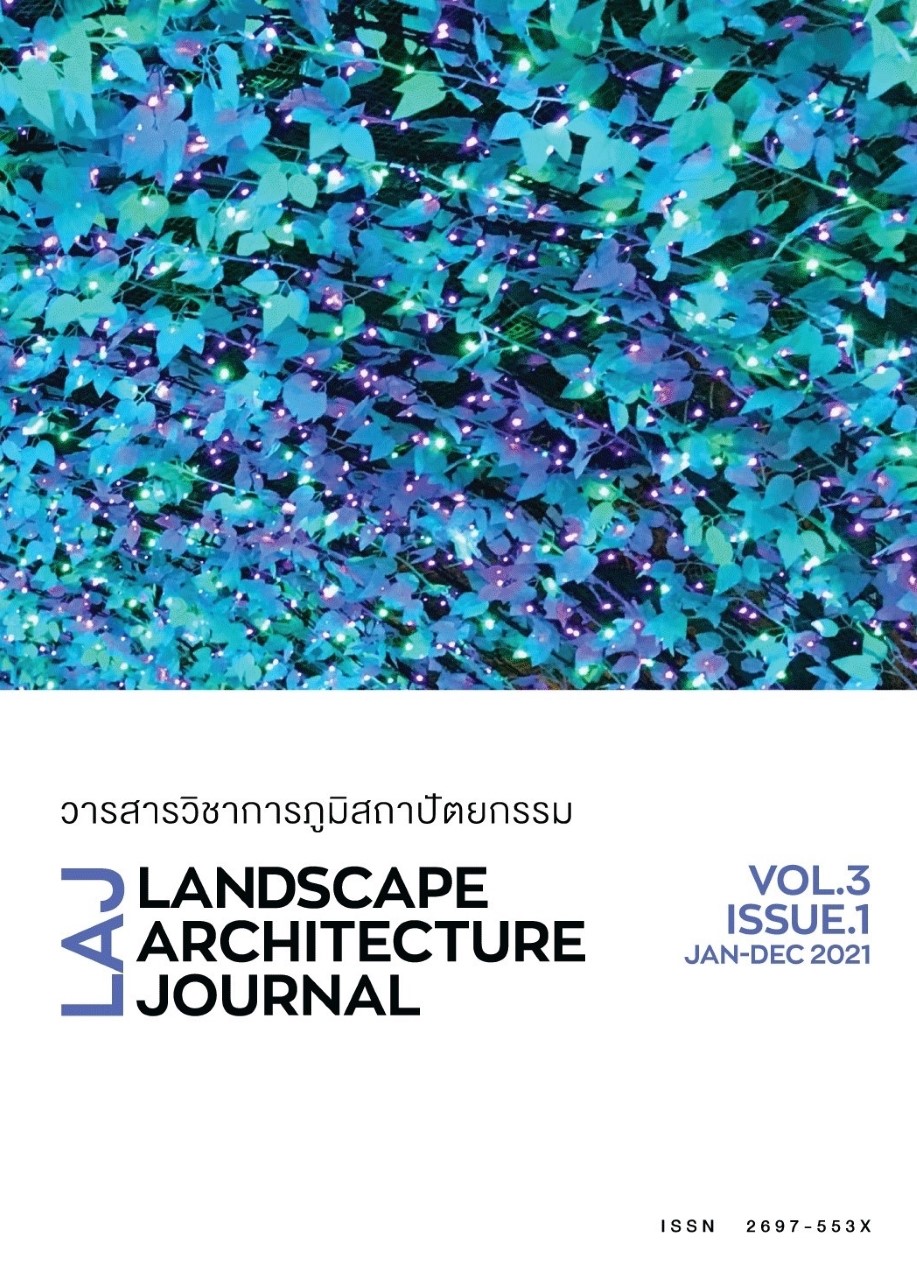Potential Spatial Analysis of West Coast Tourism Development Zone for Wellness Tourism Destination
Main Article Content
Abstract
This research article contains two objectives; to study the potential spatial analysis of west coast zone (Thailand Riviera) and develop the area to be a wellness tourism destination. The study area covers Phetchaburi, Prachuap Khiri Khan, Chumphon, and Ranong province. The secondary data gathering, site survey, evaluation potential physical environment along with the analysis method leads to appropriate suggestions for tourism development. The prior phase of the study found that there are 18 potential tourism sites which could be identified tourism image following the physical environment. The overall tourism image of the west coast tourism development zone should be the wellness tourism destination. Phetchaburi province has a holistic wellness tourism destination; therefore, it should enhance tourist services, facilities, and other tourist activities. Prachuap Khiri Khan province has a recreation wellness tourism and should be developed into family and wellness city. Chumphon province has an eco wellness tourism; thus, it should develop a link to the gulf of Thailand and Andaman area. Ranong province has a romantic and retreat wellness image; hence, it should be developed to high-class wellness tourism destination. According to potential spatial analysis of the 18 tourism sites, Hua Hin is capable to be transformed into transportation center of the west coast tourism development zone. Subsequently, the study proposes Hua Hin and also Pran Buri - Sam Roi Yot area to be enhanced as a hub of west coast tourism development zone or Thailand Riviera Capital.
Article Details

This work is licensed under a Creative Commons Attribution-NonCommercial-NoDerivatives 4.0 International License.
References
กรมทรัพยากรทางทะเลและชายฝั่งทะเล. (2561). สถานการณ์กัดเซาะชายฝั่งรายจังหวัด. สืบค้นจาก https://km.dmcr.go.th/th/ c_55/d_19042
กรมทรัพยากรธรณี. (2559). การกัดเซาะชายฝั่งทะเลประเทศไทย. สืบค้นจาก http://www.dmr.go.th
กระทรวงการท่องเที่ยวและกีฬา. (2560). แผนแม่บทพัฒนาการท่องเที่ยวในเขตพัฒนาการท่องเที่ยวฝั่งทะเลตะวันตก(รายงานฉบับสมบูรณ์). กรุงเทพฯ: สำนักงานปลัดกระทรวงการท่องเที่ยวและกีฬา.
เขมลักษณ์ คุปคีตพันธ์ และปริญญา บรรจงมณี. (2563). แนวทางการพัฒนาองค์ประกอบการท่องเที่ยวเชิงสุขภาพของนักท่องเที่ยวชาวยุโรปในจังหวัดประจวบคีรีขันธ์. วารสารบัณฑิตศึกษา มหาวิทยาลัยราชภัฏวไลยอลงกรณ์ ในพระบรมราชูปถัมภ์, 14 (1), 1-13.
พนิต ภู่จินดา และยศพล บุญสม. (2016). แนวคิดการพัฒนาเมืองต้นแบบ (Urban Design Guideline for Specific Purposed Towns). เจ-ดี : วารสารวิชาการการออกแบบสภาพแวดล้อม, 3 (1), 20-43.
ภาวิณี เอี่ยมตระกูล. (2561). การสัญจรวิถีเมืองอย่างยั่งยืน (Sustainable Urban Mobile). กรุงเทพฯ: โรงพิมพ์มหาวิทยาลัยธรรมศาสตร์.
ภาวิณี เอี่ยมตระกูล. (2563). การวางแผนและการพัฒนาเมืองเพื่อความยั่งยืน (Sustainable Urban Planning and Development). กรุงเทพฯ: โรงพิมพ์มหาวิทยาลัยธรรมศาสตร์.
ธนวัต ลิมป์พาณิชย์กุล และคณะ. (2562). แนวทางการพัฒนาการท่องเที่ยวในพื้นที่ฝั่งทะเลตะวันตก ของประเทศไทย: มุมมองจากการศึกษาต้นแบบริเวียร์ร่าและนักท่องเที่ยวศักยภาพ (Guidelines for Tourism Development in Thailand’s Royal Coast: An Outside-In Perspective). รายงานวิจัยฉบับสมบูรณ์เสนอต่อสำนักคณะกรรมการส่งเสริมวิทยาศาสตร์ วิจัย และ นวัตกรรม (สกสว.). สิงหาคม 2562.
สำนักงานปลัดกระทรวงการท่องเที่ยวและกีฬา. (2560). แผนพัฒนาการท่องเที่ยว ฉบับที่ 2 (พ.ศ. 2560 - 2564). กรุงเทพฯ: สำนักงานกิจการโรงพิมพ์องค์การสงเคราะห์ทหารผ่านศึก.
สำนักพัฒนาการท่องเที่ยว กรมการท่องเที่ยว กระทรวงการท่องเที่ยวและกีฬา. (2550). คู่มือการประเมินมาตรฐานคุณภาพแหล่งท่องเที่ยวประเภทชายหาด. สืบค้นจาก http://www.tourism.go.th
องค์การบริหารพัฒนาพื้นที่พิเศษเพื่อการท่องเที่ยวอย่างยั่งยืน (องค์การมหาชน). (2553). คู่มือการประเมินพื้นที่ท่องเที่ยวเพื่อการประกาศพื้นที่พิเศษเพื่อการท่องเที่ยวอย่างยั่งยืน. กรุงเทพฯ: องค์การบริหารพัฒนาพื้นที่พิเศษเพื่อการท่องเที่ยวอย่างยั่งยืน (องค์การมหาชน).
Broadhurst, R. (2001). Managing environment for leisure and recreation. London: Routledge.
Franklin, A. (2003). Tourism: An Introduction. Thousand Oaks, CA: Sage Publication, Inc.
Hoang, H. T., Truong, Q. H., Nguyen, A. T., & Hens, L. (2018). Multicriteria Evaluation of Tourism Potential in the Central Highlands of Vietnam: Combining Geographic Information System (GIS), Analytic Hierarchy Process (AHP) and Principal Component Analysis (PCA). Sustainability, 10 (9), 3097.
Mill, C. & Morrison, A. M. (2012). The tourism system. 7th ed. Kendall Hunt Publishing Company.
Mueller, H., & Kaufmann, E. L. (2001). Wellness tourism: Market analysis of a special health tourism segment and implications for the hotel industry. Journal of vacation marketing, 7 (1), 5-17.
The Global Wellness Institute. (2018). Global Wellness Tourism Economy – November 2018. Retrieved from https://globalwellnessinstitute.org.
Zhan, H., Liu, S., & Shao, Q. (2015). Evaluation of eco-tourism resources of forest nature reserves based on grey cluster model. Journal of Grey System, 27 (3), 249.

